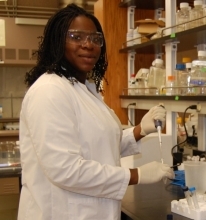
University:
Jackson State University
Major:
Biology
Mentor(s):
Xiqing Wang
Anh Vu
Faculty Sponsor(s):
Frederick Dahlquist
Faculty Sponsor's Department(s):
Chemistry and Biochemistry
Project Title:
INVESTIGATING THE ACTIVATION OF HISTIDINE KINASE CHEA IN BACTERIAL CHEMOTAXIS
Project Description:
Bacterial chemotaxis is where bacteria can direct their movements according to the chemical changes in their environment. The bacterial chemotaxis system in Escherichia coli is one of the most understood signal transduction pathways in prokaryotic organisms. The signaling complex which is composed of a transmembrane receptor, histidine protein kinase CheA and adaptor protein CheW plays an important role in chemotaxis signaling pathway.
Chemoattractants or chemorepellents bind to the transmembrane receptor transmitted a signal to CheW and CheA. CheW links CheA and transmembrane receptor together. This signaling complex regulates CheA phosphorylation activity. Once CheA is activated, it transfers a phosphoryl group to CheY. Phosphoryl CheY binds to the flagella motor and rotates the flagella motor to clockwise. Previously, research showed that CheA interacts with a transmembrane receptor, but how CheA and receptor interact with each other and activate kinase activity are unknown. Here we want to investigate the interaction between the CheA and receptor protein by using mutagenesis
and phosphorylation assay. We picked 384 of Tsr receptor to study the interaction. For the experiments we used CheA as a control, wild-type and a mutant for Tsr. The proteins were subjected to radioactive ATP and SDS dye. Our results indicated that Tsr receptor mutant, I384A, interfered with the binding sites of the ternary complex. We concluded that there is no interaction between CheA and Tsr mutant. Residue I384 of Tsr receptor is important for binding to the proteins.
